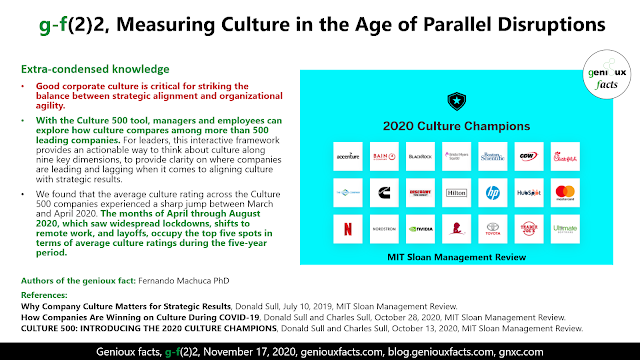Extra-condensed knowledge
- Good corporate culture is critical for striking the balance between strategic alignment and organizational agility.
- With the Culture 500 tool, managers and employees can explore how culture compares among more than 500 leading companies. For leaders, this interactive framework provides an actionable way to think about culture along nine key dimensions, to provide clarity on where companies are leading and lagging when it comes to aligning culture with strategic results.
- We found that the average culture rating across the Culture 500 companies experienced a sharp jump between March and April 2020. The months of April through August 2020, which saw widespread lockdowns, shifts to remote work, and layoffs, occupy the top five spots in terms of average culture ratings during the five-year period.
- During times of crisis the quality of communication is central to how employees evaluate corporate culture.
Condensed knowledge
- MIT SMR, Why Company Culture Matters for Strategic Results. Relying on culture — rather than detailed rules or micromanagement — to shape behavior provides employees the flexibility to seize unexpected opportunities, adapt to local circumstances, and respond quickly to shifting market conditions. Corporate culture, like an organization’s strategic priorities or objectives and key results, represents a powerful way to align behavior with a company’s strategy and mission while allowing employees to exercise judgment and initiative. Culture, in short, is critical to striking the balance between strategic alignment and organizational agility.
- MIT SMR, How Companies Are Winning on Culture During COVID-19. At first glance, you might expect COVID-19 to be a disaster for corporate culture. Our ongoing analysis of 1.4 million employee-written reviews on Glassdoor, however, tells a very different story. To examine how the pandemic has influenced employees’ perceptions of corporate culture, we looked month by month at how workers at Culture 500 companies rated their employer for the five years through August 2020. When current or former employees review a company, they are asked to rate its culture and values on a five-point scale, from “very dissatisfied” to “very satisfied.”
- Employees of Culture 500 companies gave their corporate leaders much higher marks in terms of honest communication and transparency during the first six months of the coronavirus pandemic compared with the preceding year.
- Employees were twice as likely to discuss the quality of communication by top leaders in positive terms during the months of the pandemic than they were a year earlier. In fact, they were 88% more likely to write positively about leaders’ honesty and transparency (46%). Employees also expressed more positive sentiment about transparency (42%) and communication (35%) in general. Companies on our Culture Champions list, including HubSpot, Hilton, Ultimate Software, Nordstrom, and HP Inc., scored particularly well on transparent communication during COVID-19.
- The theme of transparent communication is relatively rare among official corporate values. In an earlier study of the corporate value statements of more than 500 larger companies, we found that only 12% listed transparency or communication among their official corporate values. Because it is relatively rare in corporate culture statements, transparent communication is not included among our Big 9 values measured in the Culture 500. During times of crisis, however, the quality of communication is central to how employees evaluate corporate culture.
- Of course, not everything was good news. Culture 500 employees spoke more negatively about their company’s lack of agility during the first six months of COVID-19 than they did in the preceding year. Employees spoke more negatively about the level of bureaucracy, the complexity of processes, the speed in responding to changes, and a lack of entrepreneurship.
- Comparing the Extremes. To gain insight into what the best companies did differently during the first six months of the pandemic, we first calculated the difference in a company’s average score across culture values before and during COVID-19. The typical company experienced a small increase in its culture values score, but a few companies saw their scores rise significantly. We created a subset of the 50 companies in our sample that experienced the biggest gain in their culture values score (the top 50) and compared them with the 50 companies that experienced the largest decline on that measure (the bottom 50).
- Communication again emerges as the most important differentiator between companies that saw a significant boost in their culture values score and those that suffered a sharp decline. The top 50 companies excelled at transparent leadership, effective top team (senior leadership) communication, and clearly communicating strategy throughout the organization, and they fared well in employees’ general assessment of transparency throughout the company.
- MIT, CULTURE 500: INTRODUCING THE 2020 CULTURE CHAMPIONS. Recent analysis of Culture 500 companies reveals a set of 21 organizations that lead their industries when it comes to cultural excellence. Rises high above peers. The Culture 500 measures company performance across nine cultural values — agility, collaboration, customer orientation, diversity, execution, innovation, integrity, performance, and respect. These values are among the most frequently cited by large companies in their official corporate culture value statements as well as by employees in company reviews, and they are linked to a variety of desirable outcomes like financial performance, innovation, and employee engagement.
Category 2: The Big Picture of the Digital Age
[genioux fact extracted from MIT SMR]
Authors of the genioux fact
References
- Why Company Culture Matters for Strategic Results, Donald Sull, July 10, 2019, MIT SMR, MIT Sloan Management Review.
- How Companies Are Winning on Culture During COVID-19, Donald Sull and Charles Sull, October 28, 2020, MIT SMR, MIT Sloan Management Review.
- CULTURE 500: INTRODUCING THE 2020 CULTURE CHAMPIONS, Donald Sull and Charles Sull, October 13, 2020, MIT SMR, MIT Sloan Management Review.



